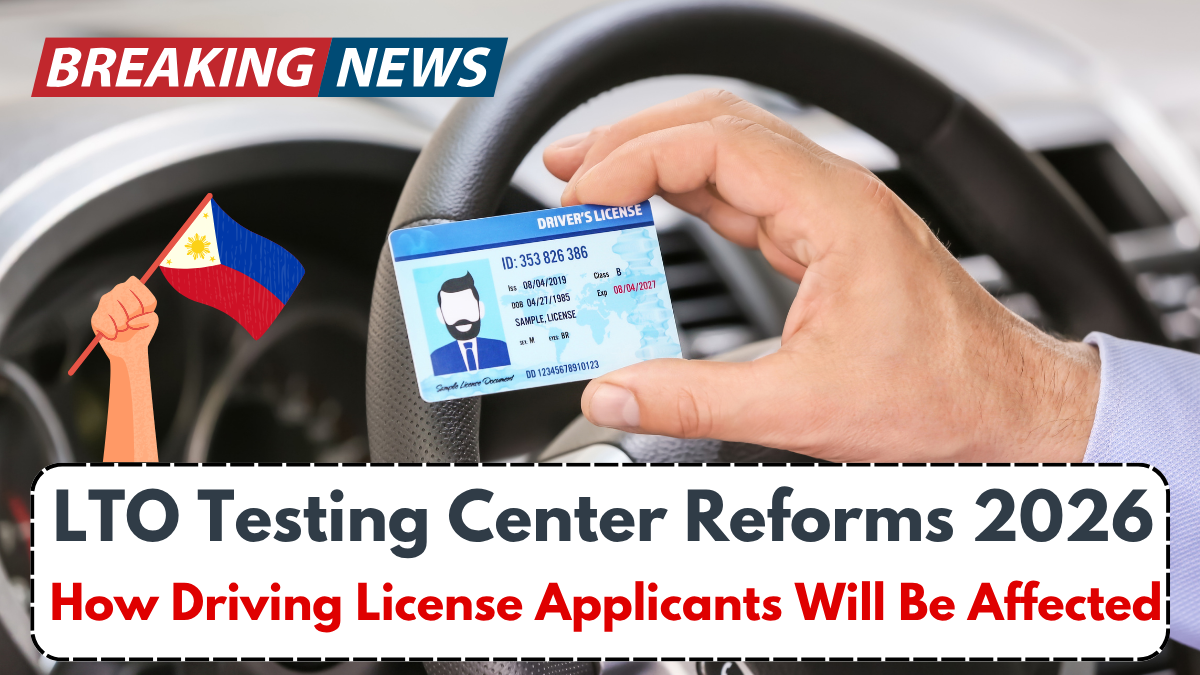The Land Transportation Office (LTO) is implementing sweeping changes in 2026 aimed at overhauling its testing and licensing system. The LTO Testing Center Reforms Philippines 2026 are being introduced to raise driving standards, address road safety issues, and modernize outdated protocols. These developments mark a turning point for applicants seeking a driver’s license in the country.
Under the new system, LTO will be rolling out stricter evaluation procedures, digital monitoring tools, and updated testing modules. Applicants must prepare for a more rigorous assessment process that evaluates both theoretical understanding and practical skills in real-world conditions.

Philippines Driving Test Changes: What’s Different in 2026?
The reforms introduce several structural changes to the licensing process. Notably, the written exam will now include scenario-based questions that reflect actual road conditions and local traffic laws. This shift ensures drivers can apply knowledge critically, rather than just memorize facts.
On the practical side, the driving test will be conducted in controlled environments that simulate urban, rural, and highway driving. Additionally, automated scoring systems and dashboard cameras will be standard across all LTO testing centers to ensure transparency and reduce human error.
A significant highlight is the introduction of mandatory pre-test driving courses from accredited training centers. Applicants must now complete and pass these courses before they can even book an official LTO driving test slot. These courses will focus on real-time hazard response, traffic law application, and responsible driving behavior.
Key Updates in LTO Rules 2026
| Area of Change | Pre-2026 Rules | Post-2026 Reforms |
|---|---|---|
| Written Exam | Multiple-choice format | Scenario-based, critical thinking required |
| Practical Test | Basic skills evaluation | Multi-environment simulated testing |
| Monitoring Tools | Manual scoring | Automated scoring with camera tracking |
| Pre-Test Requirements | Optional driving school | Mandatory accredited driving course |
| Scheduling System | Manual or semi-automated booking | Fully digitized and centralized platform |
LTO Rules 2026: Raising the Bar for Road Safety
The overarching goal of the LTO rules 2026 is to create a competent, informed, and responsible driving population. With rising traffic accidents linked to driver negligence and poor training, the LTO is doubling down on qualification standards. The new protocols are designed not just to test but to teach, ensuring that every applicant internalizes key safety principles before hitting the road.
Training centers will be monitored regularly to ensure curriculum compliance and instructional quality. Instructors will undergo certification programs to align their teaching with the LTO’s new national standards. This initiative aims to create consistency across all regions, regardless of access to urban infrastructure.
License Exam Updates: Tech-Driven and Transparent
The upcoming license exam updates introduce several digital elements to minimize fraud and ensure fairness. Biometric registration, real-time video surveillance, and blockchain-based recordkeeping are part of the new tech stack. These systems will track applicant progress from enrollment to licensure, helping eliminate inconsistencies and corruption.
Moreover, the LTO will introduce a digital feedback loop for failed applicants. This system will provide detailed performance analytics and personalized recommendations for improvement, promoting a culture of growth rather than punishment.
Conclusion: 2026 Reforms as a Blueprint for Safer Roads
The LTO Testing Center Reforms Philippines 2026 signal a major pivot in how the country views and manages road safety. These reforms, while challenging for applicants, are built to foster long-term behavioral change and accountability. The Philippines is moving toward a data-driven, skill-focused model that aligns with international standards. For aspiring drivers, the message is clear: study hard, train well, and take the new rules seriously.
FAQs
How will the LTO Testing Center Reforms Philippines 2026 affect new applicants?
New applicants will undergo a more comprehensive and rigorous process, including mandatory driving courses, digital monitoring, and multi-layered testing.
What are the biggest Philippines driving test changes in 2026?
Scenario-based written tests, simulation-based practical exams, and the use of automated scoring tools are among the biggest changes.
Are the new LTO rules 2026 already in effect?
The full implementation begins in January 2026, but pilot programs and preparatory updates have already started in selected regions.
What happens if I fail the new driving test under the 2026 system?
You will receive a digital report outlining your weak areas and suggested training steps before you can reapply.
Is it mandatory to enroll in a driving school under the new license exam updates?
Yes, only applicants who complete an accredited driving course will be eligible to take the new LTO driving tests in 2026.
Click here to know more.
Akesh is a talented content writer known for creating captivating and impactful narratives. He understands what resonates with audiences and tailors his content to inform, inspire, and engage. From blog posts and articles to marketing copy, his work consistently combines creativity with clarity. His skillful writing strengthens our brand’s voice and ensures our message leaves a meaningful impression.



